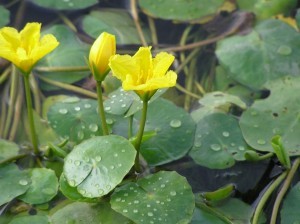Yellow floating heart
Learn about yellow floating heart, and how you can help prevent the introduction and spread of this aquatic invasive plant.
What Ontario is doing
To prevent the further spread of this species in the province, Ontario has regulated yellow floating heart (Nymphoides peltate) as a restricted invasive species under the Invasive Species Act, 2015.
Learn about the Invasive Species Act and regulations.
Background
Yellow floating heart is a floating aquatic plant found in still or slow-moving rivers, lakes, ponds, and artificial habitats, including ditches and canals. Usually growing at water depths of 1–1.5 m, these plants are tolerant of low temperatures, allowing them to persist in areas with cold climates, such as Ontario.
This plant is spread through:
- online purchase
- movement of watercraft carrying plants between waterbodies
- natural dispersal through waterways
Yellow floating heart can spread through plant fragments and produce large numbers of seeds, allowing it to quickly establish large numbers in newly introduced areas.
Range
Yellow floating heart is native to:
- Europe
- Asia
- the Mediterranean
It has become established in Canadian provinces, including:
- British Columbia
- Nova Scotia
- Newfoundland
- Ontario
In Ontario, there has been a series of reported infestations in Mississauga and Halton Hills, located in the Great Lakes basin west of Toronto.
View an up-to-date distribution map of yellow floating heart in North America.
Impacts of yellow floating heart
- The dense areas of yellow floating heart can reduce native vegetation and food available to aquatic life.
- Yellow floating heart is able to take up nutrients from the soil and release them into the water during the growing season which can lead to eutrophication (an increase in nutrient concentration in the water leading to excessive plant and algae growth).
- The yellow floating heart can change the chemical composition of their waterbodies.
- Recreational activities, such as boating and swimming, may become difficult with dense mats, which are costly to remove.
How to identify yellow floating heart
- It is an aquatic, bottom-rooted perennial plant.
- The stems are long and branched, reaching up to one metre or more.
- It is located below the surface of the water.
- The leaves are circular or heart shaped and about 3–10 cm, which float on the surface of the water.
- The flowers consist of five bright yellow petals and the seed capsules contain numerous flat, oval seeds.
What you can do
- Learn how to identify yellow floating heart and how to prevent the introduction or spread of this aquatic plant in local waterways.
- It is illegal to transport, deposit, release or bring yellow floating heart into a provincial park or conservation reserve in Ontario.
- It is illegals to buy, sell, lease, trade or grow/keep yellow floating heart, such as in aquariums or outdoor gardens in Ontario.
- Always clean, drain, and dry your watercraft (boat, canoe, etc.) if removing it and transporting it to another waterbody.
- As of January 1, 2022, boaters must open or remove drain plugs and other devices to allow water to drain, and take reasonable measures to remove plants, animals and algae from their watercraft, watercraft equipment and trailer before transporting it overland. In addition, boaters must ensure watercraft, watercraft equipment and trailers do not have aquatic plants, animals, or algae attached to it before arriving at a launch site or placing the watercraft into any waterbody.
Reporting illegal activity
Report any information about the illegal importation, distribution, or sale of floating yellow heart, to either:
- the ministry at
1-877-847-7667 , toll-free anytime - Crime Stoppers anonymously at
1-800-222-TIPS (8477) .
If you’ve seen yellow floating heart or another invasive species in the wild, please:
- contact the toll free Invading Species Hotline at
1-800-563-7711 - visit EDDMapS Ontario
- search for the ‘Invasive Species in Ontario’ project on iNaturalist.org to report a sighting
Gallery
Figure 1 Illustration of Yellow Floatingheart, Nymphoides peltata (Hallier 1883). The illustration shows A) a single petal, with a basal crest of hairs and short marginal fringe, and B) a longitudinal section through the flower and pistil.
Yellow floating heart floating leaves and flowers. Photo: Greg Bales

